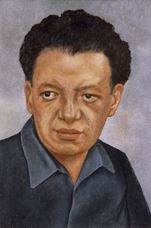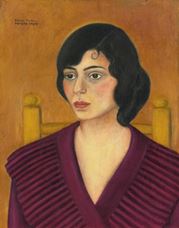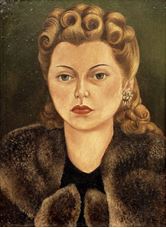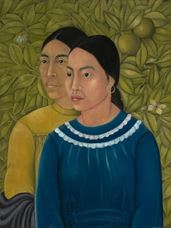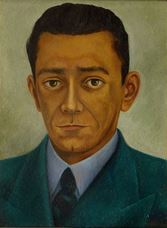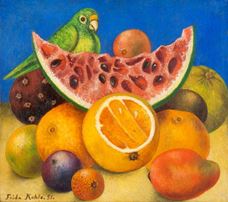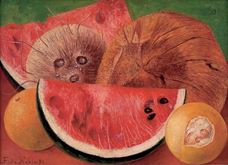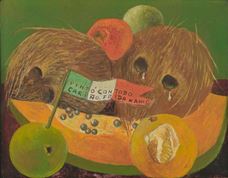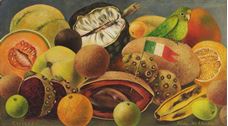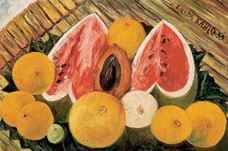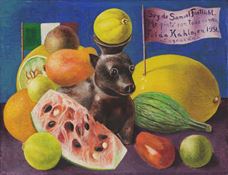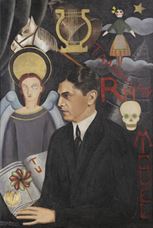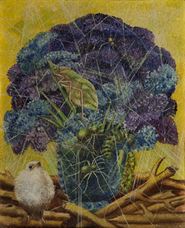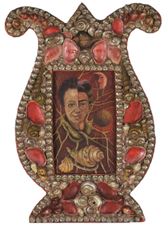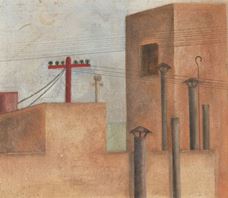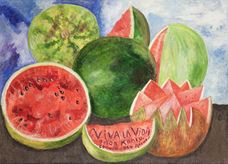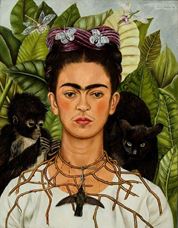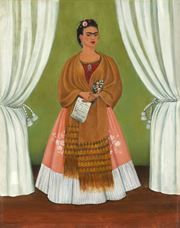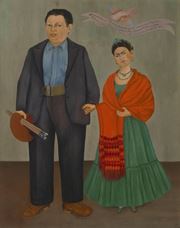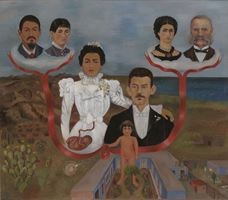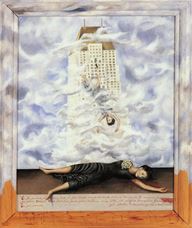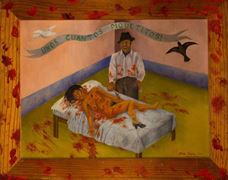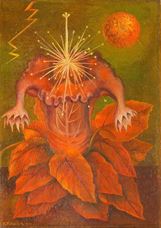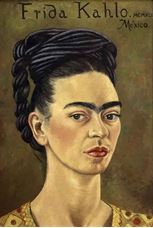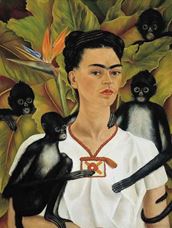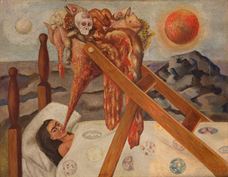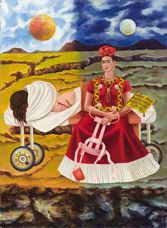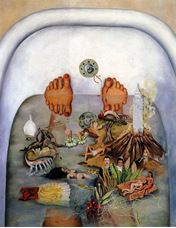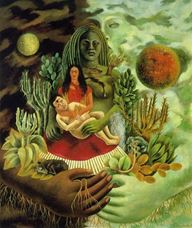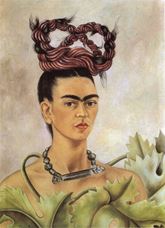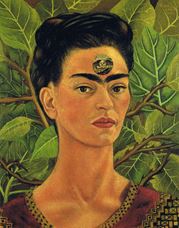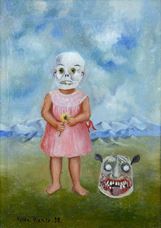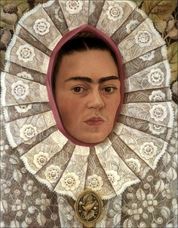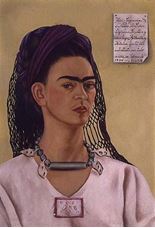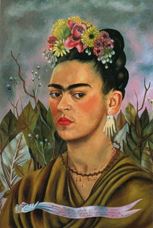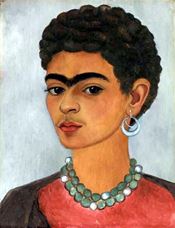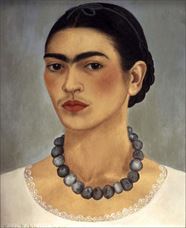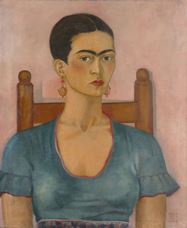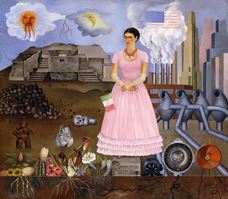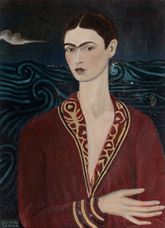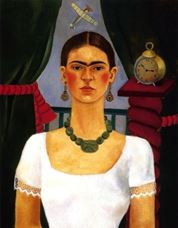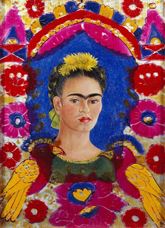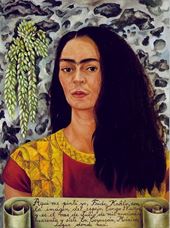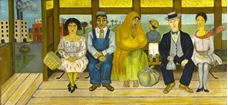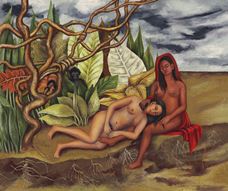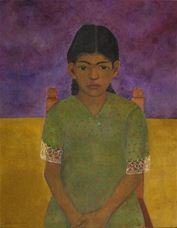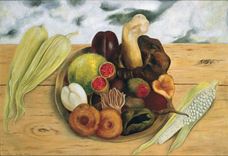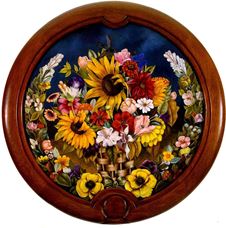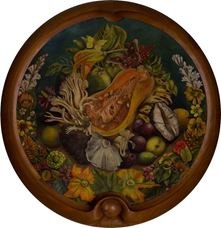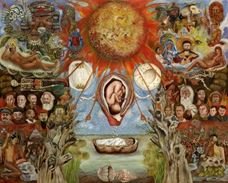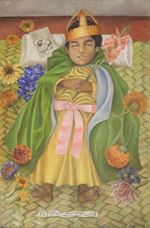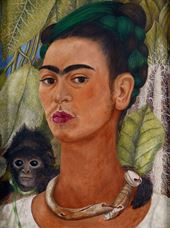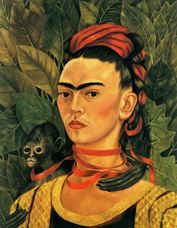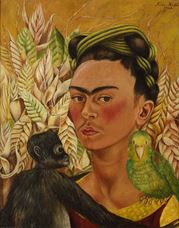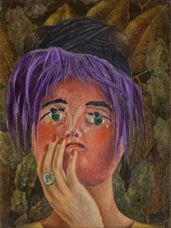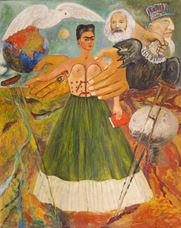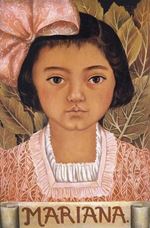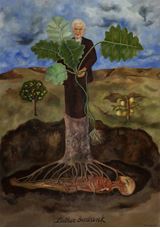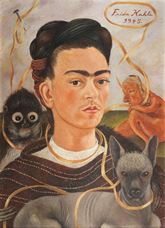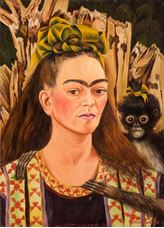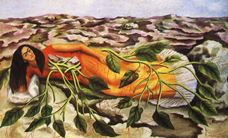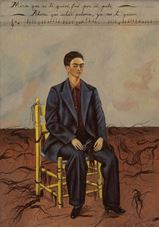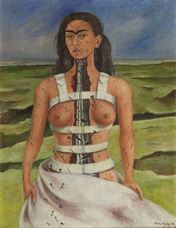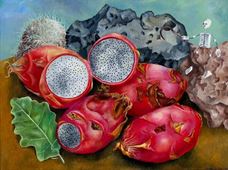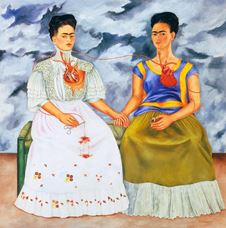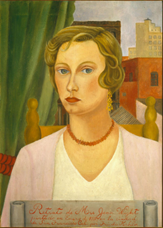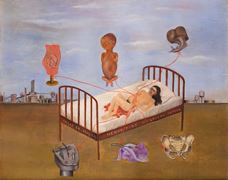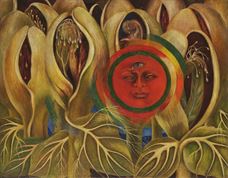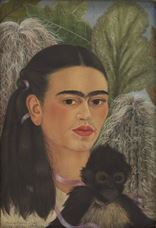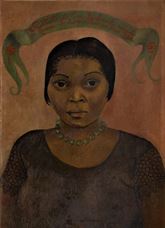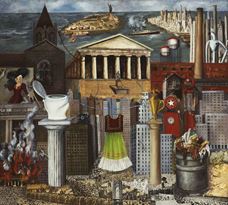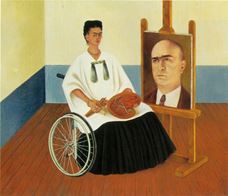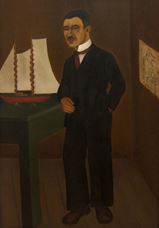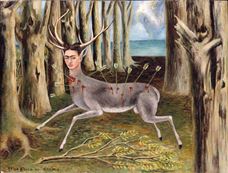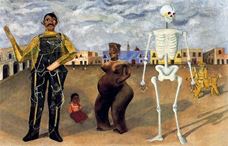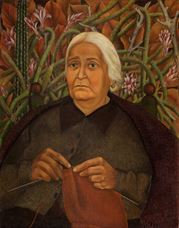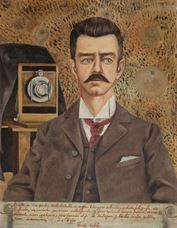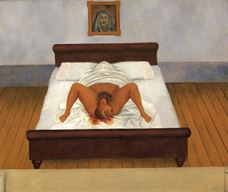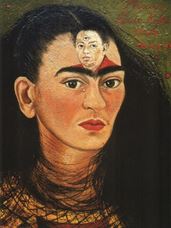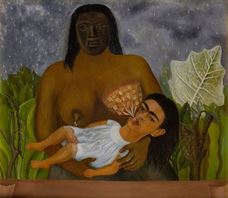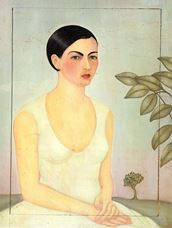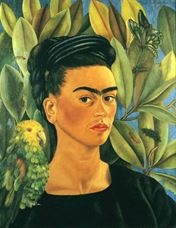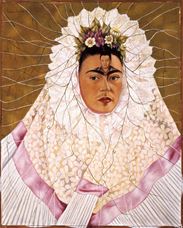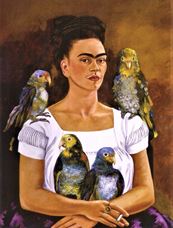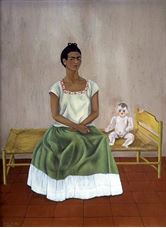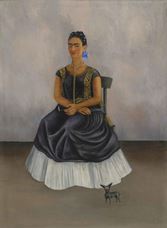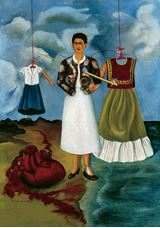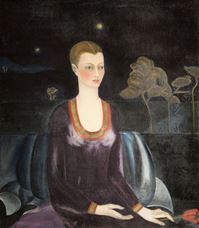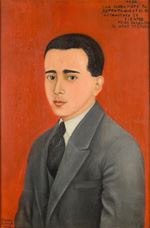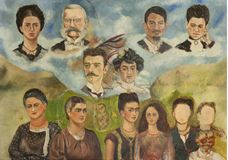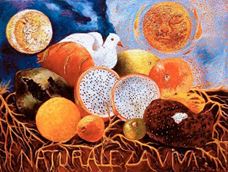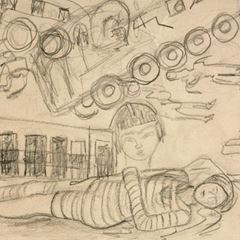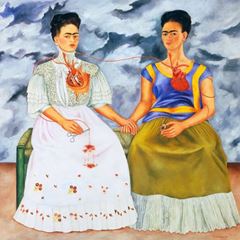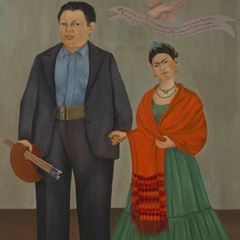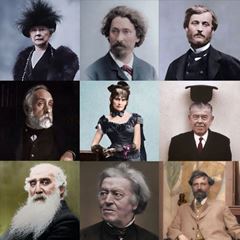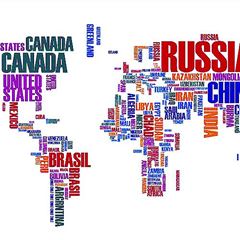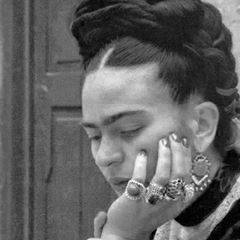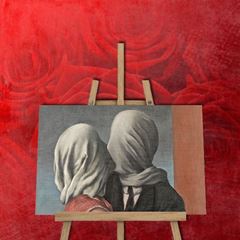On Tumblr.com, a user named "Paintters.co" colorized a lot of the black-white photos of world-famous painters. Examples of this photographic new works...
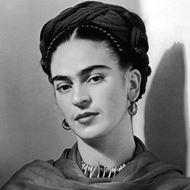
Frida Kahlo
Magdalena Carmen Frida Kahlo y Calderón was born on July 6, 1907, in Coyoacán, south of Mexico. Guillermo Kahlo and Matilde were one of four daughters of Calderón y González.
Guillermo Kahlo, with the encouragement of his wife, head towards the profession of his father-in-law, who was also a photographer. Guillermo had advanced until professionalism in the photography field. His father had built the Blue House (Casa Azul), where Frida would grow, before her birth.
When her mother fell ill, she was going to give Frida a Mexican Native American foster-mother. Her older sisters would be raising their, Frida and younger sister Cristina from her infancy.
Frida had a polio-related disease when she was only six years old. Because of this inconvenience, Frida would remain closed in her room for nine months. This disease led to the thinning of the right leg. With the close attention and support of her father, he had physical exercise and sports treatment under the supervision of a doctor.
Frida had a brilliant intelligence in fifteen. She won the National Preparatory School, one of the best schools in Mexico. It was the year when girls were new to the school. Thirty-five of the two thousand students were girls. Frida wanted to study medicine.
Frida became a member of the group with the name "Cachuchas", referring to the name caps at school. In the "Cachuchas" group there were two girls and nine people. The members of this group were to be the cornerstones of the intellectual and academic life of Mexico in the future. Alejandro Gómez Arias, another member of the upper class, would have another significance for Frida. With Alejandro, she would be a friend, and in the summer of 1923, she would be her beloved.
Frida had to work to support her family. He worked as an accountant in a sawmill, a cashier in a pharmacy. She went into a factory learning shorthand and typewriter. She worked as an apprentice in her father's friend Fernando Fernández's relief workshop. Frida was more interested in the relief work. Fernández saw great talent in Frida. He taught her the fineness of painting.
17 September 1925 was a dark history for the unlucky Frida. The bus they riding with Alejandro collided with a tram. In the accident, where there was a loss of life, Frida's had entered metal parts in many parts of her body. Alejandro was injured in the accident with scratches and bruises. Frida was taken to the operating room immediately in the "Red Cross Hospital". She was in bad shape. Frida had severe fractures in her collarbone, spine, buttock and right leg. Frida's had dislocation the right foot and was crushed. She had dislocation on her left shoulder. On Frida's left hip, a metal rod was stuck like an arrow. This metal rod went out of Frida's vagina. The metal rod opened a very deep wound on Frida's body. The wounds she received in the accident were like the bitter evidence that Frida had been saved cheaply.
Frida left the hospital on October 17th. For Frida, there was a long period of convalescence, which she had to spend still in the plaster. She recovered completely three months later, but one year later her illness recurred. Frida would remain tied to a bed for months with plaster corsets and a device attached to her right foot.
Her parents designed a bed for Frida. With its mirror on the ceiling, this colonnaded bed would be a turning point in Frida's life. She started painting with the help of a mirror. In 1926, at the age of nineteen, Frida produced the painting "Self Portrait in a Velvet Dress" for Alejandro. That was Frida's first painting.
Alejandro, sent by her family to Germany, returned in November 1927. Frida was starting to move. Though she could not attend the classes effectively, she was once again a part of her old school friends.
At the beginning of 1928, Frida was first contacted by art circles. Because of Alejandro's relationship with another woman, Frida ended his relationship. Almost all the artists struggled for communism. Frida in a short time became a close friend with photographer Tina Modotti. A few months later she joined the Communist Party. Modotti's home was a gathering center where discussions on the country's way and art were held. Here she met Diego Rivera, one of Mexico's most famous painters. In fact, Frida met Diego, who made a mural for school in 1922 when she was a student at the National Preparatory School. Diego, whom she admires his art after a few meetings, was not indifferent to Frida's work. Frida invited Diego to the Blue House to show her paintings. This is how the relationship between Diego and Frida started. This relationship would last until both of them died.
Frida was the first to paint after marriage. His first pregnancy coincides with this period. Frida's health has no hand, so she has to undergo an abortion. After marriage, Frida was the first time oriented towards painting. Her first pregnancy coincides with this period. Frida had to have an abortion because of health problems.
In 1930, Diego received an invitation from the United States for her mural. This was the first trip Frida had ever made. When they came to San Francisco, the relapse of the pain in Frida's right leg was the occasion to meet Dr. Leo Eloesser. Dr. Eloesser, a famous thoracic surgeon specializing in bone surgery, would be Frida's friend, confidant, medical consultant. Frida painted "Portrait of Dr. Eloesser" as an expression of her gratitude to the doctor. During this period of immobility, she started painting again.
Frida and Diego moved to Mexico in June 1931. Diego, while working on their new home in the San Angel area of Mexico City, he stayed with Frida at the Blue House. In November they went to New York for Diego's affairs. In April of 1932, they were in Detroit. Diego was working very hard. Frida was pregnant for the second time. It was a miracle for her to give birth because of the bodily disturbances she experienced. On the night of July 4, she lost her baby as a result of severe bleeding. Frida made baby-themed sketches at the Henry Ford Hospital during treatment. She painted "Henry Ford Hospital" on July 17, with oil paintings on a metal plate.
Frida learned that her mother Matilde's condition was getting worse. She left Diego in America and went to Mexico on her own. She lost her mother on September 15. She stayed in Mexico for a month. She finished the painting "My Birth", which she started before going to Mexico when she returned to Detroit.
The couple returned to Mexico City in 1934 for their home in San Angel. Frida struggling with diseases also took a blow from Diego. In America, Diego had been aware of her relations with other women. However, Diego also had an affair with Frida's younger brother, Cristina. At the beginning of 1935, Frida left home and moved to an apartment in the city center. In 1935, she moved to New York with her two friends. These experiments did not resolve the problem. She returned to Mexico City in the realization that they needed each other with Diego.
The Blue House, where Frida spent her childhood, was going to be the scene of a host to the world's political history in 1937. It would be the refuge of the revolutionary Lev Trotsky and his wife in exile. For two years the Blue House would turn into a castle. In this period when Trotsky stayed at the Blue House, he would have a brief love with Frida. For this short-term love Frida lived, she gave Trotsky a self-portrait as a farewell.
Frida leaned into her professional life more disciplined and attentive. Shee improved her technical skills. In the period 1937-38, she produced more works than the first eight years of her marriage.
In the summer of 1938, American actor Edward G. Robinson bought four paintings of Frida. This was the first big sale of the artist. This was the beginning of the economic and artistic independence of the sale. In November, she opened her first solo exhibition in New York. Over half of her work on display here has been sold. The press showed positive interest in Frida and the first orders were coming: The important orders Frida received were "Self-Portrait with Monkey" (1940) and "The Suicide of Dorothy Hale" (1939). The exhibition would also have led Frida to meet photographer Nickolas Muray, who would later become a love affair.
The works of Frida were exhibited in Paris in 1939. Although he was not commercially successful, she had received enough attention and dignity. From Yves Tanguy to Picasso, she had won the admiration of many painters. During this period, her love affair with Muray finished and returned to Mexico. The art scene was shaken by Diego's new love affair. Frida left Diego in San Angel and moved to the Blue House. At the end of the year, Frida and Diego divorced.
Frida's physical pain was accompanied by her spiritual pains, and she had terrible pains in her spine. In spite of everything, she was painting with appetite. Unlucky Frida "Monkey Self-portrait", "Self-Portrait with Cropped Hair", "Self-Portrait with Thorn Necklace and Hummingbird" was done in this period.
In 1940, Frida took part in the International Surrealist Exhibition in Mexico City with of her two works. In a short period of time, she would participate in many exhibitions in America. Her paintings were considered by many critics, especially André Breton, as examples of surrealism. Frida was just saying that she painted her own reality.
Her health deteriorated, Frida went to San Francisco in 1940 for a series of surgeries. Diego was living in San Francisco at the time. Diego's marriage proposed to Frida again. Frida accepted the marriage proposal in return for some conditions. The first anniversary of their divorce was remarried on December 8th.
In 1943, Diego and Frida became teachers at the La Esmeralda art school in Mexico City. Because Frida's health was not good, she was teaching at her home. In 1944, she was wearing a steel corset for a while to relieve her sorrows. Frida would describe this corset in detail in her painting "The Broken Column".
Frida was in New York in 1946 for spinal surgery. The four vertebrae of Frida were combined with a piece of the hip bone and metal with a length of fifteen centimeter. Back pain was alleviated. When she returned to Mexico, Frida was first confined to a bed, and then eight months in a steel corset. She lost weight, had anemia and worsened spine pains. The painting was back on the stage like the medicine of all these pains. Frida worked non-stop for hours.
Frida had to go to hospital in 1950. She would stay there for a year. Dr. Juan Farill, a major Mexican surgeon, performed a new series of bone transplants. Frida spent the period of convalescence at home. To pay his debt of gratitude to her doctor, she made "The Portrait of Doctor Farill". She began to take her medications in very high doses to relieve their pain. This overload caused brush strokes and artistic discipline to move away.
In April 1953, Frida's first solo exhibition was held in Mexico as "Respect to the Frida's". Although Frida's health was poor, she insisted on going to the opening. She participated in the exhibition on the hospital stretcher. Frida's exhibition has achieved a great deal of success over the Mexican borders. The gallery would extend the exhibition for another month, due to the intense demand for the exhibition.
Frida's right leg, worsening in 1953, her right leg was cut for to gangrene. The cut leg was replaced with a prosthesis. In the face of this pathetic situation, Frida was unresponsive and silent. In early 1954, she forced herself to get out of bed and started to go back to the painting studio. Frida was working on the picture table attached to the wheelchair. From time to time she continued her work in her bed.
With her wheelchair, Frida stubbornly supported the action of the Communists on 2 July. This was the last meeting with the crowds.
On July 13, 1954, Frida Kahlo had her eyes closed due to lung embolism. Frida's last painting was a still life called "Viva la Vida, Watermelons", made of red watermelons.
Bibliography;
Jamis, R., (2016). Frida Kahlo: Aşk ve Acı, Onbirinci Basım, Everest Yayınları, İstanbul.
Herrera, H., (2003). Frida, Birinci Basım, Bilgi Yayınevi, Ankara.
Burrus, C., (2011). Frida Kahlo: Kendi Gerçeğimin Resmini Yapıyorum, Yapı Kredi Yayınları, İstanbul.
Haz; Erdoğan, Ö. (2009), Dâhiler ve Aşkları, Üçüncü Baskı, İkaros Yayınları, İstanbul.
Lunday, E., (2013). Büyük Sanatçıların Gizli Hayatları, Beşinci Baskı, Domingo Yayınevi, İstanbul.
Rona, Z., (1997). “Frida Kahlo”, Eczacıbaşı Sanat Ansiklopedisi 2, YEM Yayınları, İstanbul.
1907 She was born on July 6 in Coyoacán, south of Mexico. Her father, Guillermo Kahlo; Her mother was Matilde Calderón González. She was the third of four sisters. The name of the sisters respectively; Matilde was Adriana, Cristina.
1913 She was polio. Frida couldn't leave her room for nine months. There was thinning of the right leg.
1922 She entered the National Preparatory School of Mexico. She joined the group "Cachuchas" in school. She met Diego Rivera. She changed the date of birth to 1910 due to the Mexican Revolution. She started using her name Frida.
1923 “Frida lived in love with Alejandro Gómez Arias, the leader of the group "Cachuchas".
1925 She began to work as an apprentice at Fernando Fernández. September 17, seriously injured in a bus accident. She left the hospital on October 17th.
1926 She spent a lot of time in bed because of the accident. She started painting this period. Her first work was "Self Portrait in a Velvet Dress".
1927 Between March and November, Frida communicated with Alejandro in Europe.
1928 She left with Alejandro. She met Julio Antonio Mella, the Cuban communist. She made friends with Tina Modotti. She became a member of the Communist Party. She met Diego Rivera.
1929 On August 21, she married Diego. In December, together with Diego, they lived together with Cuernavaca near Mexico City. She had her first pregnancy from Diego and had to undergo an abortion because of her health.
1930 On November 10th, they went to San Francisco with Diego. She met Dr. Leo Eloesser.
1931 She made "Frida and Diego Rivera". In June they moved with Diego to the Blue House in Mexico. In November, they returned to New York.
1932 They went to Detroit in April. She got pregnant a second time. On July 4, Henry Ford made a miscarriage at the hospital. Frida stayed in the hospital for thirteen days. She made "Henry Ford Hospital" work. She lost her mother on September 15. She lived in Mexico for a month. On October 21, she returned to Detroit. She made a painting "My Birth".
1933 In March, Diego, and Frida returned to New York. She "My Dress Hangs There" table. She returned to Mexico on 20 December. She moved to their home in San Angel.
1934 She had her third pregnancy and she had a forced abortion because of health problems. She learned the relationship between her sister Cristina with Diego. She left San Angel in 1935. She started living in an apartment in the center of Mexico City. She went to New York in July. She returned to her home in San Angel and made a deal with Diego again.
1937 Frida was introduced to Lev Trotsky and his wife, Natalia Sedova, who was exiled in January and stayed in the Blue House. There was a brief love affair between Frida and Trotsky. She gave Trotsky the self-portrait and was saying farewells.
1938 André Breton and his wife Jacqueline Lamba visited Trotsky and Frida. Actor Edward G. Robinson received four paintings of Frida. Thus, she made her first significant sale. She went to New York in October. She opened her first solo exhibition in November at the "Julien Levy Gallery".
1939 She went to Paris in January. On March 10th, she participated in a "Mexican" exhibition at Pierre Colle Gallery. She divorced Diego on November 6th.
1940 She attended the International Surrealism Exhibition in January. She was questioned on August 20 for two days about the killing of Trotsky. In September She was treated by Dr. Eloesser in San Francisco. She attended the Golden Gate International Exhibition. She was shown the painting "The Two Fridas" at the Modern Art Museum's Twenty Centuries exhibition of Mexican Art. She remarried Diego on December 8th.
1941 She lost her father on April 14. She participated in the exhibition Modern Mexican Artists of the Institute of Modern Art, Boston.
1942 She sold her house in Mexico City for support and began building the "Anahuacalli" museum with Diego.
1943 She started to teach at the art college "La Esmeralda". She did a decorative mural painting study near the Blue House with her Students.
1944 She started writing the diary. She had her first steel corset experience.
1945 She painted "Moses" with the influence of Freud's "Moses and Monotheism".
1946 She went to New York in May and had spinal surgery in June. She returned to Mexico in October. She lived with a steel corset for eight months.
1950 She underwent a bone transplantation surgery by Dr. Farill at the British Hospital in Mexico City.
1951 She made the painting "Self-Portrait of the Doctor Farill".
1953 In April, Frida organized her first solo exhibition at the "Galerías de Arte Contemporáneo" in her country. Despite the doctors' warning, she attended the exhibition with an ambulance. In August Frida's right leg was cut to the bottom of the knee due to gangrene.
1954 On July 2, Frida joined the communist demonstration. She died on 13 July due to pulmonary embolism. Her last work was the painting "Viva la Vida, Watermelons", where she painted watermelons.
Accident and After - Frida Kahlo
On the afternoon of September 17, 1925, Frida boarded one of the city buses with her lover Alejandro Gómez Arias. A tram from Xochimilco hit this bus to Coyoacán right in the middle. The result of the accident, which killed so many people, would be very severe for Frida.
The Two Fridas - Frida Kahlo
One of Frida Kahlo's most famous paintings, "The Two Fridas", was made in 1939, when Diego Rivera and Frida ended their eleven-year marriage.
In the table there are two Frida sitting side by side on a bench and facing the viewer. One is the unloved Frida, who is divorced from Diego, and the other one is Diego's lover Frida.
Frida and Diego Rivera - Frida Kahlo
"I fell in love with Diego, but my family didn't like it, because Diego was a communist and ours compared him to fat or fat Brueghel. They said it resembled the marriage of a white dove with an elephant..."
Most Searched Painters on Google in 2020!
Social media and blogger named Gareth EVANS wanted to find out which artists were most searched on google in 2020 in the world during the pandemic process. EVANS showed the most popular artists searched by each country on the world map.
Aphorisms - Frida Kahlo
"It is the life story of Frida Kahlo, standing tall despite all the pain and longing she experienced with the enormous flowers she carries on her head and her passion for painting."
Lovers of Painters
The female models reflected by the painters on their paintings are the most important elements and indispensables for the painters. The female models in the masterpieces of many painters stole the hearts of the painters and then were reflected in their paintings as their lovers and wives. Examples of the spouses that add meaning to the lives and paintings of painters for February 14 Valentine's Day.













